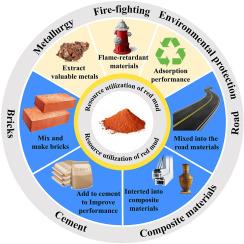赤泥在建材领域的研究现状及减碳分析
IF 4.3
2区 材料科学
Q2 ENGINEERING, CHEMICAL
引用次数: 0
摘要
赤泥是氧化铝生产过程中产生的高碱性工业固体废物,其特点是粒径细,重金属残留。其大量积累对环境和生态系统构成严重威胁。本文对建筑材料中赤泥的研究现状及其在碳减排方面的潜力进行了系统综述。研究了赤泥的物理化学性质及其在水泥基材料、道路建筑、建筑砌块、陶瓷和复合材料中的应用。研究表明,在建筑材料中使用赤泥可以显著提高赤泥的利用率,同时减少生产过程中的碳排放。例如,赤泥可用于生产低熟料复合水泥,可用于提高沥青混合料的抗水损伤性能,可用于提高未烧结砖和陶瓷制品的力学性能和耐久性。此外,它的固碳能力为开发减碳建筑材料提供了实质性的支持。然而,赤泥的大规模应用仍然受到关键技术挑战的限制,包括预处理成本高、性能优化有限以及环境安全评估不足。本文概述了未来的研究方向,并提出了促进赤泥广泛利用减碳的策略,从而为铝产业的绿色转型提供理论框架和技术支撑。本文章由计算机程序翻译,如有差异,请以英文原文为准。

Research status and carbon reduction analysis of red mud in the field of building materials
Red mud, a highly alkaline industrial solid waste generated during the production of alumina, is characterized by its fine particle size and residual heavy metals. Its massive accumulation poses a serious threat to the environment and ecosystems. This paper provided a systematic review of the current research on red mud in building materials and its potential for carbon reduction. It examined the physicochemical properties of red mud and its applications in cement-based materials, road construction, building blocks, ceramics, and composite materials. Researches indicated that utilizing red mud in building materials could significantly increase its utilization while simultaneously reducing carbon emissions during production. For instance, red mud can be employed in the production of low-clinker composite cement, used to improve the water damage resistance of asphalt mixtures, and integrated to enhance the mechanical properties and durability of unfired bricks and ceramic products. Moreover, its carbon sequestration capacity offered substantial support for developing carbon-reducing building materials. Nonetheless, the large-scale application of red mud remains constrained by critical technical challenges, including high pre-treatment costs, limited performance optimization, and insufficient environmental safety assessments. This paper outlined future research directions and proposes strategies to promote the extensive utilization of red mud for carbon reduction, thereby providing a theoretical framework and technical support for the green transformation of the aluminum industry.
求助全文
通过发布文献求助,成功后即可免费获取论文全文。
去求助
来源期刊

Particuology
工程技术-材料科学:综合
CiteScore
6.70
自引率
2.90%
发文量
1730
审稿时长
32 days
期刊介绍:
The word ‘particuology’ was coined to parallel the discipline for the science and technology of particles.
Particuology is an interdisciplinary journal that publishes frontier research articles and critical reviews on the discovery, formulation and engineering of particulate materials, processes and systems. It especially welcomes contributions utilising advanced theoretical, modelling and measurement methods to enable the discovery and creation of new particulate materials, and the manufacturing of functional particulate-based products, such as sensors.
Papers are handled by Thematic Editors who oversee contributions from specific subject fields. These fields are classified into: Particle Synthesis and Modification; Particle Characterization and Measurement; Granular Systems and Bulk Solids Technology; Fluidization and Particle-Fluid Systems; Aerosols; and Applications of Particle Technology.
Key topics concerning the creation and processing of particulates include:
-Modelling and simulation of particle formation, collective behaviour of particles and systems for particle production over a broad spectrum of length scales
-Mining of experimental data for particle synthesis and surface properties to facilitate the creation of new materials and processes
-Particle design and preparation including controlled response and sensing functionalities in formation, delivery systems and biological systems, etc.
-Experimental and computational methods for visualization and analysis of particulate system.
These topics are broadly relevant to the production of materials, pharmaceuticals and food, and to the conversion of energy resources to fuels and protection of the environment.
 求助内容:
求助内容: 应助结果提醒方式:
应助结果提醒方式:


